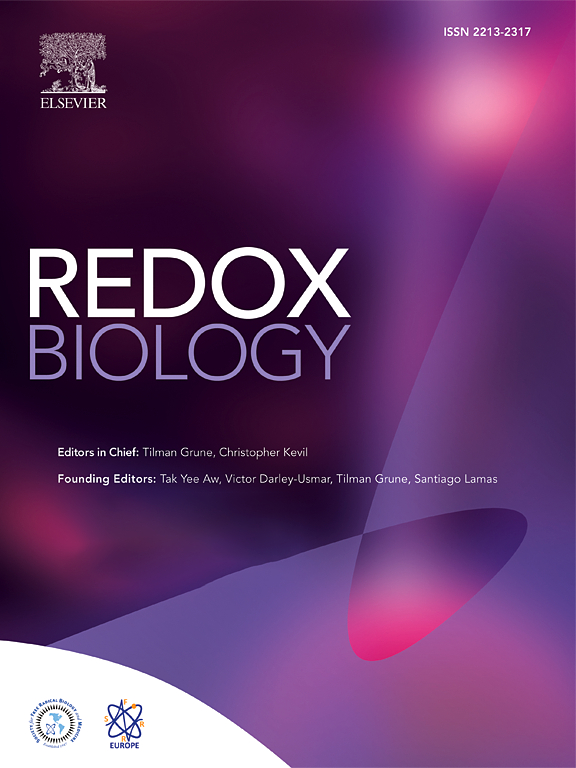Regulatory roles of NAMPT and NAD+ metabolism in uterine leiomyoma progression: Implications for ECM accumulation, stemness, and microenvironment
IF 10.7
1区 生物学
Q1 BIOCHEMISTRY & MOLECULAR BIOLOGY
引用次数: 0
Abstract
Uterine leiomyoma (UL), commonly referred to as benign tumors, is characterized by excessive cell proliferation, extracellular matrix (ECM) accumulation, and the presence of stem cell-like properties. Nicotinamide adenine dinucleotide (NAD+) metabolism, regulated in part by nicotinamide phosphoribosyltransferase (NAMPT), plays a crucial role in these pathological processes and has emerged as a potential therapeutic target. Additionally, redox signaling pathways are integral to the pathogenesis of UL, influencing the dynamics of NAD+ metabolism. This study sought to elucidate the regulatory functions of NAMPT and NAD+ metabolism, in conjunction with redox signaling, in the progression of UL, and to explore potential therapeutic strategies targeting these pathways. Evaluation of NAMPT expression in human UL tissues revealed a positive correlation between elevated NAMPT levels and increased ECM deposition, as well as the expression of stemness markers. The use of FK866 and nicotinamide (NAM), to inhibit NAMPT significantly suppressed UL cell viability and attenuated stem cell-like characteristics. Redox signaling pathways, including those associated with DNA damage, lysosomal function homeostasis, and redox-sensitive phagophore formation, were implicated in the regulation of ECM dynamics, particularly through ECM-targeted inhibition. This study highlights the pivotal roles of NAMPT, NAD+ metabolism, and redox signaling in the pathophysiology of UL. Targeting NAMPT, particularly through the use of inhibitors FK866 and NAM, represents a promising therapeutic approach for mitigating UL progression by modulating redox and ECM dynamics. These findings offer novel insights into UL pathogenesis and establish NAMPT as a compelling target for future clinical investigation.
NAMPT 和 NAD+ 代谢在子宫肌瘤进展中的调控作用:对 ECM 积累、干性和微环境的影响
子宫肌瘤(UL)通常被称为良性肿瘤,其特点是细胞过度增殖、细胞外基质(ECM)堆积以及具有干细胞样特性。烟酰胺腺嘌呤二核苷酸(NAD+)代谢部分由烟酰胺磷酸核糖转移酶(NAMPT)调节,在这些病理过程中起着至关重要的作用,并已成为潜在的治疗靶点。此外,氧化还原信号通路与 UL 的发病机制密不可分,影响着 NAD+ 代谢的动态变化。本研究旨在阐明 NAMPT 和 NAD+ 代谢以及氧化还原信号在 UL 进展过程中的调控功能,并探索针对这些途径的潜在治疗策略。对人类 UL 组织中 NAMPT 表达的评估显示,NAMPT 水平的升高与 ECM 沉积的增加以及干性标志物的表达呈正相关。使用FK866和烟酰胺(NAM)抑制NAMPT可显著抑制UL细胞的活力,并减弱干细胞样特征。氧化还原信号通路,包括与DNA损伤、溶酶体功能平衡和氧化还原敏感性吞噬体形成相关的通路,都与ECM动态调控有关,特别是通过ECM靶向抑制。这项研究强调了 NAMPT、NAD+ 代谢和氧化还原信号在 UL 病理生理学中的关键作用。以 NAMPT 为靶点,特别是通过使用抑制剂 FK866 和 NAM,是通过调节氧化还原和 ECM 动态来缓解 UL 进展的一种很有前景的治疗方法。这些发现为了解 UL 的发病机制提供了新的视角,并使 NAMPT 成为未来临床研究的一个引人注目的靶点。
本文章由计算机程序翻译,如有差异,请以英文原文为准。
求助全文
约1分钟内获得全文
求助全文
来源期刊

Redox Biology
BIOCHEMISTRY & MOLECULAR BIOLOGY-
CiteScore
19.90
自引率
3.50%
发文量
318
审稿时长
25 days
期刊介绍:
Redox Biology is the official journal of the Society for Redox Biology and Medicine and the Society for Free Radical Research-Europe. It is also affiliated with the International Society for Free Radical Research (SFRRI). This journal serves as a platform for publishing pioneering research, innovative methods, and comprehensive review articles in the field of redox biology, encompassing both health and disease.
Redox Biology welcomes various forms of contributions, including research articles (short or full communications), methods, mini-reviews, and commentaries. Through its diverse range of published content, Redox Biology aims to foster advancements and insights in the understanding of redox biology and its implications.
 求助内容:
求助内容: 应助结果提醒方式:
应助结果提醒方式:


